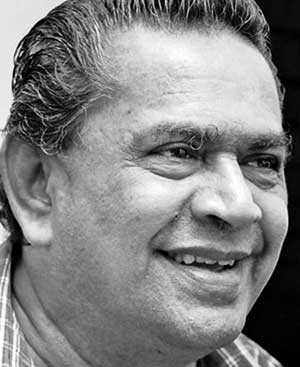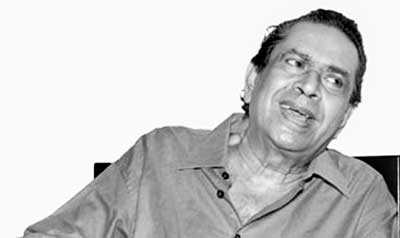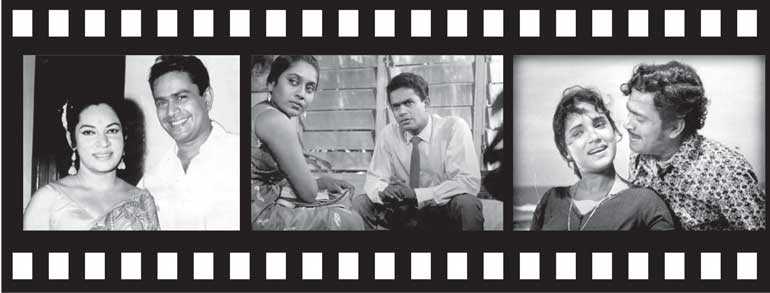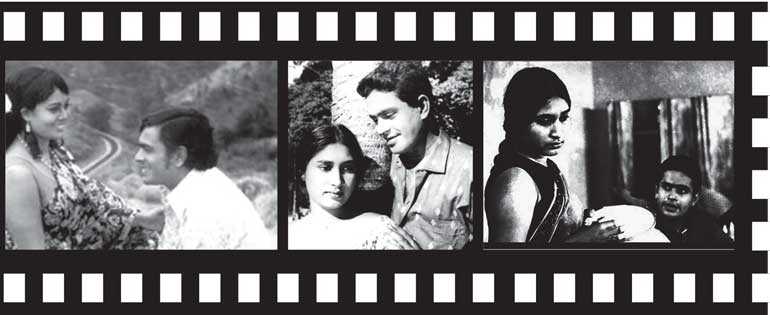Sunday Apr 20, 2025
Sunday Apr 20, 2025
Saturday, 1 September 2018 00:11 - - {{hitsCtrl.values.hits}}
 Several dashing and debonair actors have graced the Sinhala silver screen over the years. Arguably the most lovable among these cinematic heroes was the dynamic Tony Ranasinghe who acted in both lead as well as character roles.
Several dashing and debonair actors have graced the Sinhala silver screen over the years. Arguably the most lovable among these cinematic heroes was the dynamic Tony Ranasinghe who acted in both lead as well as character roles.
Tony Ranasinghe who was born on 31 July 1937 entered the film world in the early sixties of the last century. His brilliant career in filmdom spanning more than five decades came to an end with his passing away three years ago on June 16th 2015. ‘Spotlight’ intends focusing this week on Tony Ranasinghe who was a multitalented, multifaceted personality. The boy hailing from Mutwal (Modera in Sinhala and Muhathuvaaram in Tamil) with a Roman Catholic background made his mark as an actor on both stage and screen. He acted in diverse roles ranging from romantic lovers to affectionate fathers and won awards for acting in both films and plays.
Tony also made the smooth transition from the big screen to small screen and shone in TV too as an actor and script writer. Likewise he wrote the screenplay and dialogues for some films too. In later life he transformed into a playwright translating and adapting many works of William Shakespeare into Sinhala.
Remarkable thespian skills
What was most remarkable about Tony Ranasinghe’s thespian skills was that he was both a lead and character actor. A character actor according to dictionary definition is an actor who specialises in playing eccentric or unusual people rather than leading roles in films. A character actor plays unusual, strange or interesting characters instead of being the main character.
 The question then arises as to who or what is a character actor? In a sense are not all actors including those in lead roles playing a character? Therefore are not lead actors also character actors? Are we to then demarcate a line between lead roles and supportive roles and define a character actor as someone who is not the actor playing the lead role?
The question then arises as to who or what is a character actor? In a sense are not all actors including those in lead roles playing a character? Therefore are not lead actors also character actors? Are we to then demarcate a line between lead roles and supportive roles and define a character actor as someone who is not the actor playing the lead role?
A clear cut definition is not always possible but one is always able to distinguish between a lead actor and character actor when you see the film. The concept of “terrorism” for instance has still not been clearly defined but “terrorism” is always recognised by the actual deed or incident.
Likewise, it may be difficult to rigidly demarcate who a character actor is but the performances by actors on screen do give a good indication. The lead roles in films are very often repetitive and the actors playing them often become typecast. Even those playing supportive roles of the same kind can become “typecast actors”.
In contrast the role of a character actor as opposed to that of a typecast actor is an evolving one and therefore changes constantly from film to film. Particular actors are chosen to play specific roles because filmmakers believe that such and such an actor can do full justice to that part. They are selected because the director and casting directors opine that a particular actor is best suited to personify the character in question. Even if such roles have been enacted before, the director is confident that the selected actor can play the character with a distinctive difference.
In the case of Sinhala cinema, actors like Gamini Fonseka, Vijaya Kumaratunga and Ravindra Randeniya can be classified as lead actors. Actors Henry Jayasena, Joe Abeywickrama and D.R. Nanayakkara can be categorised as character actors. These spheres are generalised definitions. Both groups of actors have occasionally strayed into the other sphere but they could be generally classified into these broad categories.
A different breed
Tony Ranasinghe however was of a different breed. Tony was both a lead and character actor. Of the 119 films he has acted in, in a film career spanning more than five decades, Tony has played the lead actor in 47 and character actor roles in 72. He has played not only the romantic lover in many films but has also acted in many other roles including that of the dastardly villain. Versatility was his forte. Variety was his hallmark.
Appreciation from one’s peers is perhaps the greatest form of praise one can get. In Tony’s case both the “King” and “Queen” of Sinhala film actors have showered lavish praises on him in newspaper interviews.
 |
| In an interview a few weeks before his death, Gamini Fonseka said of him: “Tony as an actor is the best character-based actor not even witnessed in the Indian screen. He has an actor within himself who emerges at the correct moment. Tony Ranasinghe is the best character actor in Asia.” Malani Fonseka in an interview given in the aftermath of Tony’s demise said: “Tony Aiya was a well-read man of wisdom. Not only as his co-star, but also as an outsider, I tremendously enjoyed watching Tony Aiya on the screen and to date I find him the most romantic lover we’ve had in our films. There will never be another Tony.” |
In an interview a few weeks before his death, Gamini Fonseka said of him: “Tony as an actor is the best character-based actor not even witnessed in the Indian screen. He has an actor within himself who emerges at the correct moment. Tony Ranasinghe is the best character actor in Asia.”
Malani Fonseka in an interview given in the aftermath of Tony’s demise said: “Tony Aiya was a well-read man of wisdom. Not only as his co-star, but also as an outsider, I tremendously enjoyed watching Tony Aiya on the screen and to date I find him the most romantic lover we’ve had in our films. There will never be another Tony.”
It could be seen from these statements by the two Fonsekas that Gamini acknowledges Tony as the “best character actor” while Malani describes Tony Aiya as the “most romantic lover we’ve had in our films”. Very high praise indeed! But then Tony is worthy of such praise and deserves it fully. The comments by the Fonseka duo also draws attention to the dynamic duality of Tony Ranasinghe.
Malani calls him the most romantic lover. Apart from certain exceptions, the general rule in our films is the portrayal of the lead actor or hero as a lover on screen. The hallmark of a lead actor is to play the romantic lover. Thus Malaini’s praise highlights the fact that Tony was a popular lead actor playing the hero in many films. Yet, Gamini praising Tony as a character actor may appear to be somewhat contrary to that of Malani’s viewpoint. Actually it is not so and Gamini and Malani only complement each other in complimenting Tony.
Tony Ranasinghe is one actor who has straddled both spheres of lead roles and character roles simultaneously from the time he burst on screen. Tony played the lead role which was very often that of the romantic lover perfectly in several films, thereby fitting Malani’s description. Tony also played non-hero character actor roles with finesse in many films, thus deserving the kudos heaped upon him by Gamini.
Early days
Ranasinghe Hettiarachchilage Ignatius Anthony Silva was born on 31 July 1937 in Mutwal (the anglicised name for Modera/Muhathuvaaram).He was the second of eight children born to Dona Lucia Catherine and Emmanuel Cyril Silva who were both of the Roman Catholic faith.
Young Anthony studied at the Catholic institutions of St. John’s mixed school and De La Salle College in Mutwal. In between there was a stint at St. Anthony’s College in Wattala. This was due to the family shifting to Wattala after the Japanese bombing of 1942 during World War II. The family returned to Mutwal after the war ended in 1945.
Tony was known as Anthony de Silva at school then. He was very shy and never, ever acted in a school play in those days. He was interested in cricket and also read voraciously. He wanted to be a writer. At one stage he even thought of entering the priesthood. Since he was known as Anthony during his schooldays, his nickname was “Anta” derived from Anthony. This led to his classmates teasing him “Anta Panta Pol Panta” in those days.
Tony Ranasinghe, known then as Anthony de Silva, quit studies while in the SSC (Senior School Certificate) class at De La Salle College when he and his classmates were instructed to memorise the Bible in full. Tony objected to this strongly and had a fiery argument with the school director, a European Catholic Priest.
He dropped out of school and enrolled at Commercial College where he studied short-hand, typing and bookkeeping. Being weak in arithmetic, Tony failed in bookkeeping but obtained a London City and Guilds Certificate in shorthand and typewriting. He could take down shorthand at 80 words a minute and type 40 words in 60 seconds.
As an aspiring stenographer, Tony tried finding a permanent job in many places. He tried to be a Hansard reporter in Parliament as well as a court reporter. Finally he got a permanent job as English stenographer at the Department of Government Electrical Undertakings, which later became known as the Ceylon Electricity Board. With secure employment assured Tony got married to Sirima Indrani Wickremasuriya and began raising a family. The couple went on to have four children and six grandchildren.

A compulsion to act
As a schoolboy Tony had been too shy to take part in plays but as a grownup he yearned to be an actor. Even as a schoolboy he had been enamoured of acting but his shyness had stood in the way. But now the acting bug bit him hard. He was drawn towards acting. Three reasons or experiences contributed to this attraction towards acting.
All residents of Modera in those days were proud of two locals who had made a name in Tower Hall dramas of that time. They were W. Livinus Perera and S.D. Steven Silva. This made a great impact on Tony at a very tender age.
Then there was the experience of seeing the life of John the Baptist being dramatised by the parishioners of St. John’s Church in Mutwal. Tony watched the rehearsals at the church and then the final performances. Since the actors were all church members and known to him personally, young Tony was highly impressed.
The third reason was the experience of seeing two Shakespearean films screened at De La Salle College. They were ‘Hamlet’ with Laurence Olivier and ‘Julius Caesar’ with Marlon Brando. Tony has gone on record that he did not understand the films then but had been overwhelmed by Olivier and Brando. His love affair with William Shakespeare had its genesis in those two films.
Impelled by a compulsion to act, Tony began seeking out opportunities in both stage and screen. Tony’s brother Ralex was extremely supportive of his sibling’s ambition to be an actor. Ralex, then working as a copywriter at an advertising firm, was also a skilled photographer. Ralex Ranasinghe photographed his brother in many poses and from different angles. He made him dress up and pose like Gregory Peck and Humphrey Bogart and compiled a photo portfolio to be shown to prospective filmmakers.
Ralex’s efforts to launch his brother as a film actor were not very successful but he did help Tony get a break as a stage actor. A bunch of young bilingual enthusiasts of the arts, literature and cinema formed themselves into a group called “Apey Kattiya” or “Our Group”.
Among these were persons like Cyril B. Perera, Sugathapala de Silva, Dharmasiri Wickremaratna, Vipul Dharmawardene, Augustus Vinayagaratnam and G.W. Surendra. Ralex was also associated with this group. So when Sugathapala de Silva wrote the play ‘Boarding Karayo’ about people in a boarding house or chummery to be put on the boards by Apey Kattiya, Ralex was able to get his brother an opportunity to play a part in it.
Ralex had already changed his surname De Silva of Portuguese origins to the more Sinhala sounding Ranasinghe. He wanted his brother Anthony de Silva also to do the same. Ralex felt that such a name change would help him in an acting career. He wanted his brother to be named Tony Ranasinghe like the Hollywood actor Tony Curtis. Anthony de Silva was willing to transform himself as Tony Ranasinghe but kept procrastinating because of the cumbersome legal procedures involved in changing a name officially.
Meanwhile Sugathapala de Silva who also preferred the name Tony Ranasinghe to Anthony de Silva started using the name Tony Ranasinghe in preparing publicity materials for ‘Boarding Karayo’.
Realising he had to change his name quickly, Tony consulted the chief clerk at his office seeking advice on how to go change his name quickly. He was pleasantly surprised when told that as a Government servant, all he had to do was to inform the Shroff formally of the name change. This he did immediately and by the time ‘Boarding Karayo’ opened, Anthony de Silva had legally turned into Tony Ranasinghe.

Stage debut and journey thereon
‘Boarding Karayo’ featuring G.W. Surendra and Prema Ganegoda among others, was Tony Ranasinghe’s stage debut. It was a roaring success and soon Apey Kattiya went on to produce more plays. Sugathapala de Silva wrote ‘Thattu Geval’ with almost the same cast as that of ‘Boarding Karayo’.
Then came another play by Sugathapala, ‘Harima Badu Hayak’ adapted from ‘Six characters in search of an author,’ the meta-theatrical absurdist drama by Luigi Pirandello. Tony Ranasinghe acted in all three plays by Sugathapala de Silva and earned much praise from the playwright, critics and rasikas. In describing the actor, Sugathapala said: “Tony Ranasinghe is one of the few actors in our country who uses facial expressions in whatever role he plays in the most natural way. This makes him so unique.”
Despite the kudos and popularity gained by acting in Sugathapala de Silva’s plays, Tony got his first award for acting in a play by another dramatist. The play was Dharmasiri Wickremaratna’s ‘Ran Thodu’. It had a bold controversial theme relating to premarital sex and consequent loss of virginity.
The play’s plot about the heroine losing her gold earring was metaphorical of her losing her virginity. Tony Ranasinghe and Anula Karunathilaka acted magnificently. The play was a sensation. Both Tony and Anula won the Governor-General’s Award in 1963 for Best Actor and Best Actress in a Drama for their stage performances in ‘Ran Thodu’.Tony was now regarded as an accomplished stage actor.
But what of Tony Ranasinghe’s cherished ambition to blaze a name for himself on the silver screen? The tale of Tony Ranasinghe’s entry into films and subsequent rise to success and fame as an actor will be related in detail in a forthcoming article.
(D.B.S. Jeyaraj can be reached at [email protected].)